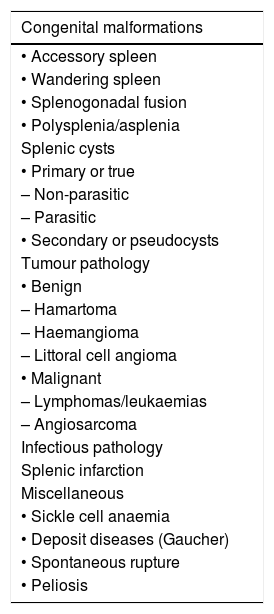The spleen is considered a “forgotten organ” by most radiologists and paediatricians despite being affected in many clinical paediatric situations. While it is the organ most often affected in paediatric abdominal trauma, non-traumatic spleen disorders are less well known.
The spleen is well visualised by any imaging technique: ultrasound, computed tomography (CT) and magnetic resonance imaging (MRI); the former is used most often in children. Using imaging techniques to determine the features of splenic anomalies, both congenital and acquired, enables a correct diagnostic approach, avoids unnecessary surgical procedures or biopsies, and helps the clinician to prescribe appropriate treatment.
Our aim was to show the behaviour of the spleen in children using the different imaging techniques: its normal anatomy, the principal anatomical variants and the most common spleen disorder correlating with clinical symptoms, serology and histology.
Para la mayoría de radiólogos y pediatras, el bazo es el “órgano olvidado”, a pesar de estar afectado en múltiples situaciones clínicas de la infancia. Mientras que en el traumatismo abdominal pediátrico es el órgano más implicado, la patología esplénica no traumática es menos conocida.
El bazo se visualiza bien mediante cualquier técnica de imagen: ecografía, tomografía computarizada, resonancia magnética, y de ellas, la primera es la más utilizada en niños. Conocer las características por imagen de las anomalías esplénicas, tanto congénitas como adquiridas, permite realizar una aproximación diagnóstica correcta, evitar procedimientos quirúrgicos o biopsias innecesarias y guiar al clínico hacia un tratamiento adecuado.
Nuestro objetivo es mostrar el comportamiento del bazo en edad pediátrica con las diferentes técnicas de imagen: su anatomía normal, las principales variantes anatómicas y la patología esplénica no traumática más frecuente, correlacionando con clínica, serología o histología.






















